



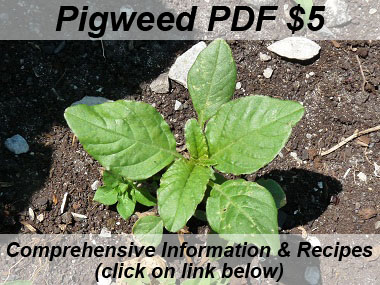
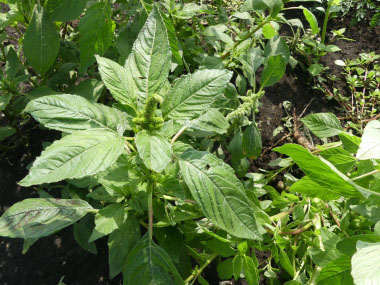
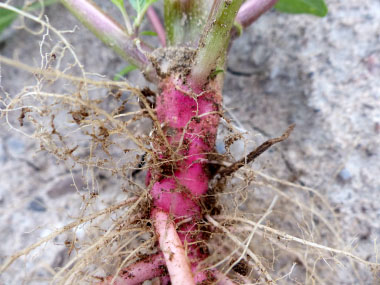
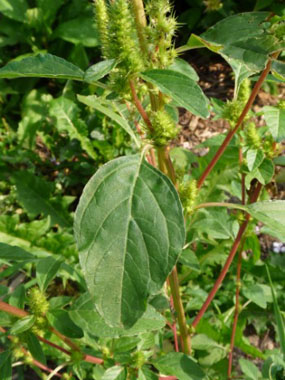
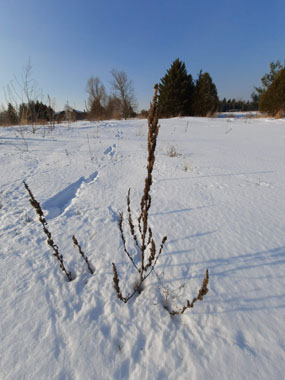
For comprehensive information (e.g. nutrition, health benefits, recipes, history, harvesting tips, etc.) please check out our Pigweed PDF magazine.
Pigweed is an annual great leafy green vegetable that many gardeners love to hate as it tends to show up in gardens uninvited. This wild edible can be a beneficial weed as well as a companion plant serving as a trap for leaf miners and some other pests; also, it tends to shelter ground beetles (which prey upon insect pests) and breaks up hard soil for more delicate neighbouring plants. Because of its valuable nutrition, some farmers grow amaranth today.
Distinguishing Features
The stem of the pigweed is what makes this plant so distinctive. Stems are erect, and can grow anywhere from 10 cm - 2 m high, but usually 50 - 90 cm, simple or branched, lower part thick and smooth, upper part usually rough with dense short hair, greenish to slightly reddish but usually red near the roots.
Flowers
The flowers are small, green and crowded into coarse, bristly spikes at the top of the plant. Smaller spikes are located in the leaf axils below.
 Fields
of Nutrition has medicinal benefits and vitamin/mineral content of Pigweed.
Fields
of Nutrition has medicinal benefits and vitamin/mineral content of Pigweed.
Leaves
The leaves are alternate on the stem, long-stalked, and range from dull green to shiny or reddish green. The leaf blade is oval to diamond-shaped, but is usually broader at the base. The margins of the leaves are smooth. The tips of the leaves are pointed or sometimes slightly notched.
Height
Pigweed can grow to 2 metres high.
Habitat
Pigweed is generally found in gardens, cultivated or abandoned fields.
Edible Parts
Young leaves can be eaten raw or cooked like spinach, sautéed, etc. Pigweed has a mild flavour and is often mixed with stronger flavoured leaves. Fresh or dried pigweed leaves can be used to make tea. The seed is very small but easy to harvest and very nutritious. The flavour is greatly improved by roasting the seed before grinding it. Pigweed seed can be ground into a powder and used as a cereal substitute, it can also be sprouted and added to salads. The seed is very small but easy to harvest and very nutritious.
Other Name
Amaranth.
Similar Plants
Lambs Quarters.
Recipes
To support our efforts please browse our store (books with health benefits, etc.).
Winter Survival Food Handbook

PDF Plant Magazines
Types of Wild Food
Geographic Zones Seasons
Disclaimer
EdibleWildFood.com is informational in nature. While we strive to be 100% accurate, it is solely up to the reader to ensure proper plant identification. Some wild plants are poisonous or can have serious adverse health effects.
We are not health professionals, medical doctors, nor are we nutritionists. It is up to the reader to verify nutritional information and health benefits with qualified professionals for all edible plants listed in this web site. Please click here for more information.
Why Edible Wild Food?
- Food costs are rising
- Free, wild food is readily abundant
- Wild food adds nutrition to your diet
- Wild food can help treat various medical conditions







